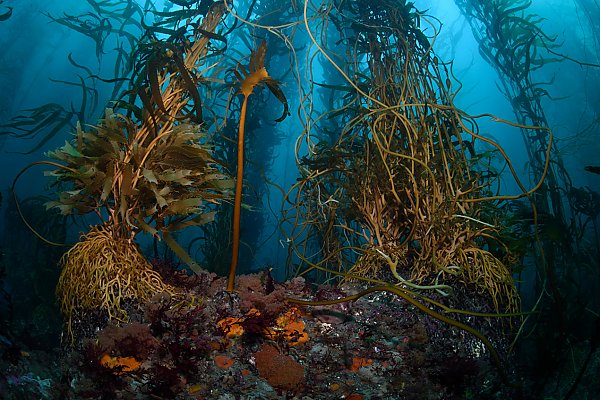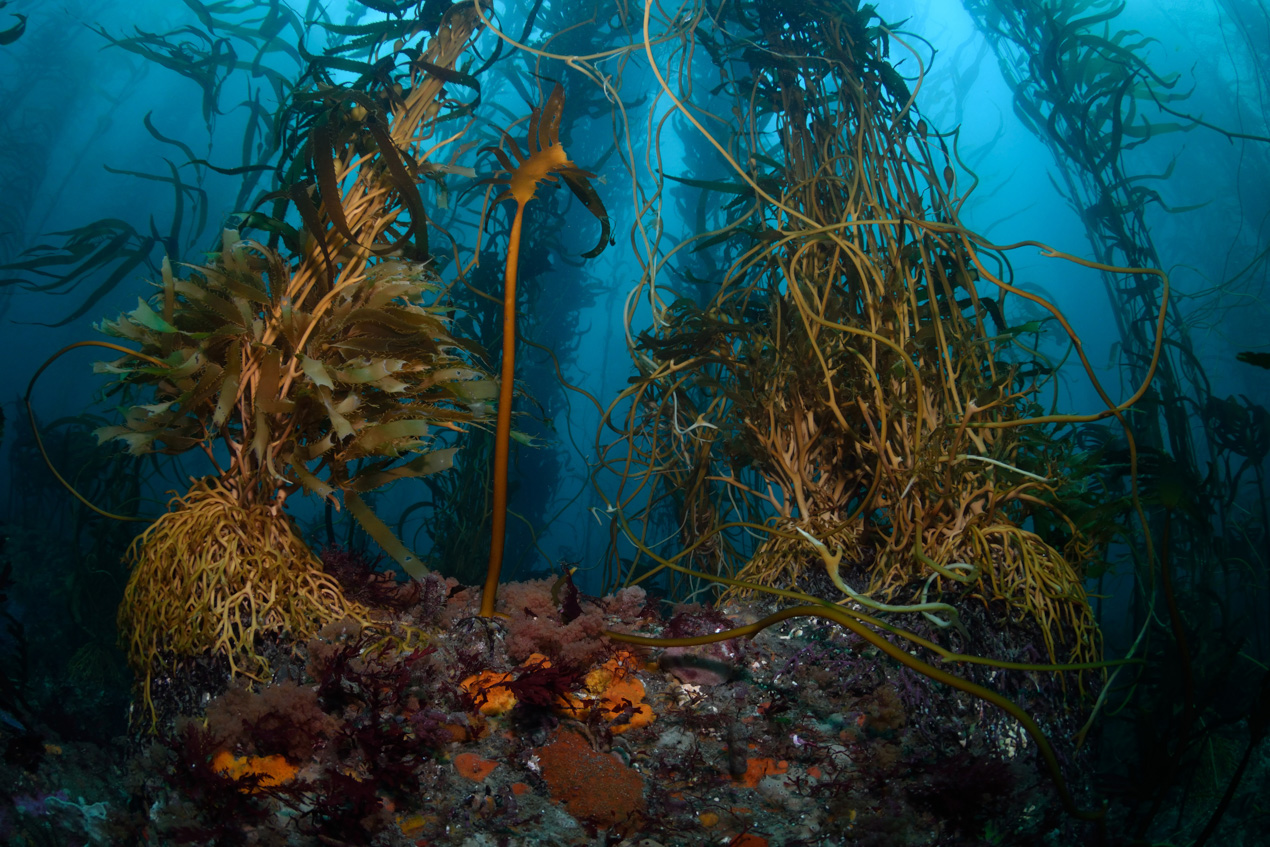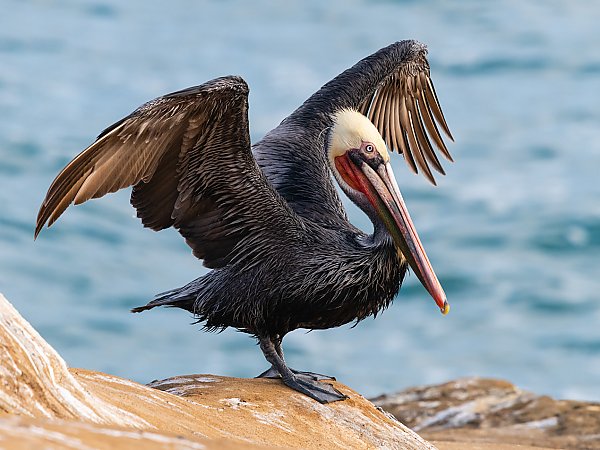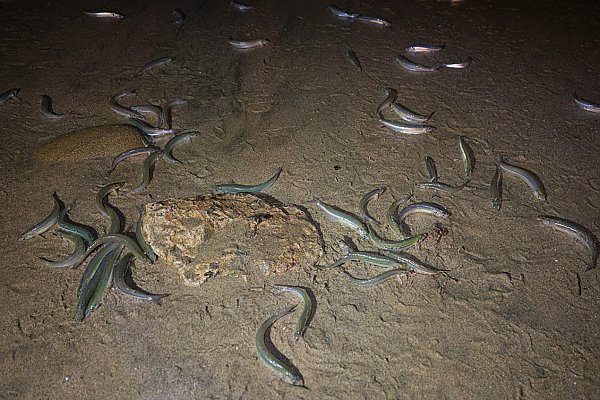

Repairing our Kelp Forests Via Species Conservation
This report examines thirty species, one species at a time. But species do not live in isolation. They are eaten by other species. They eat other species. They provide habitat. They compete.
Analyzing population trends for one species is essential for conservation, but is only the first step. Protecting marine life requires stewardship of interacting species and conservation of entire ecosystems.
California’s kelp forests embody the interdependency of species protection and ecosystem conservation. The ecological and economic value of the world’s underwater kelp forests is more than $500 billion, and that estimate does not include their value as a carbon sink or as protection against storm surge. Because kelp are food for grazers, especially purple sea urchins off the coast of California, what happens to kelp depends on what happens to urchins. Meanwhile urchins are eaten by southern sea otters and by sunflower sea stars. Ultimately then, what happens to kelp depends on what happens to sea otters and sunflower sea stars.
The loss of kelp forests around the world is considered by many marine biologists to be a crisis – somewhere between 40 and 60% decline in kelp globally over the last fifty years. The causes of the decline vary with geography but off the coast of California the major suspects are ocean warming, pollution (especially sedimentation), and disruption of species interactions. Prolonged heat stress directly damages kelp tissue and reduces survival and reproduction. The disruption of species interactions refers to the problems created by depleting the predators of purple sea urchins. The interaction between sea urchins and kelp is so strong and so important, that any major reduction in predator control of urchins can lead to overgrazing and eventually sea urchin barrens. Hence any attempt to recover kelp populations will simultaneously require recovering depleted sunflower sea star populations and recovering sea otters more fully.
Currently several conservation organizations and researchers are working to better understand the threats to kelp and are working to recover these spectacular underwater forests. Kelpwatch.org is a publicly available website at which dynamic changes through time in kelp cover is visualized at a 30-meter resolution. It was through long term monitoring of kelp off California’s coast that the impact of marine heatwaves on kelp was established. During the 2013 to 2016 marine heatwave in the eastern Pacific, bull kelp in northern California declined by 90%.
The challenge with restoring disappeared kelp forests is that even after the water cools down, barren ocean floors can persist because urchins remain out of balance. Interestingly, the few areas of the California coastline with southern sea otters were buffered against rampant urchin grazing thanks to the otters consuming urchins. To restore denuded kelp landscapes requires adding back key elements species-by-species: otters, sunflower sea stars, white abalone, black abalone, giant sea bass, and so on. At least ten of the thirty species covered in this first California Marine Report are intimately associated with kelp forests. This is a good reminder that managing and protecting ecosystems is really all about protecting species. Conservation that does not count, survey, measure and protect species is a flimsy foundation for ocean stewardship.
The good news is NOAA is funding a Pacific Ocean coalition of public and private partners that is led by Nature Conservancy, and includes partners such as Aquarium of Pacific, California Academy of Sciences, California Department of Fish and Wildlife, The Bay Foundation, Greater Farallones Association, UCSB, OPC, Sunflower Star Lab, and Paua Marine Research Group. The focus of this partnership is restoring endangered sunflower sea stars and white abalone white in combination with restoring kelp forests. Building back a depleted ecosystem from the ground up is a daunting and complicated task that demands this multifaceted collaboration. There is even a workforce development dimension to this restoration endeavor. The key lesson is that once an ecosystem has unraveled the way some kelp forests have, it is very hard to put them back together one species at a time.
- Bell, T. W., Cavanaugh, K. C., Saccomanno, V. R., Cavanaugh, K. C., Houskeeper, H. F., Eddy, N., … & Gleason, M. (2023). Kelpwatch: A new visualization and analysis tool to explore kelp canopy dynamics reveals variable response to and recovery from marine heatwaves. Plos one, 18(3), e0271477. *Eger, A. M., Marzinelli, E. M., Beas-Luna, R., Blain, C. O., Blamey, L. K., Byrnes, J. E., … & Vergés, A. (2023). The value of ecosystem services in global marine kelp forests. Nature communications, 14(1), 1894.
- Nicholson, T. E., McClenachan, L., Tanaka, K. R., & Van Houtan, K. S. (2024). Sea otter recovery buffers century-scale declines in California kelp forests. PLOS Climate, 3(1), e0000290.
- Rogers-Bennett, L., & Catton, C. A. (2019). Marine heat wave and multiple stressors tip bull kelp forest to sea urchin barrens. Scientific reports, 9(1), 15050.
- Valckenaere, J., Techera, E., Filbee-Dexter, K., & Wernberg, T. (2023). Unseen and unheard: the invisibility of kelp forests in international environmental governance. Frontiers in Marine Science, 10, 1235952.


